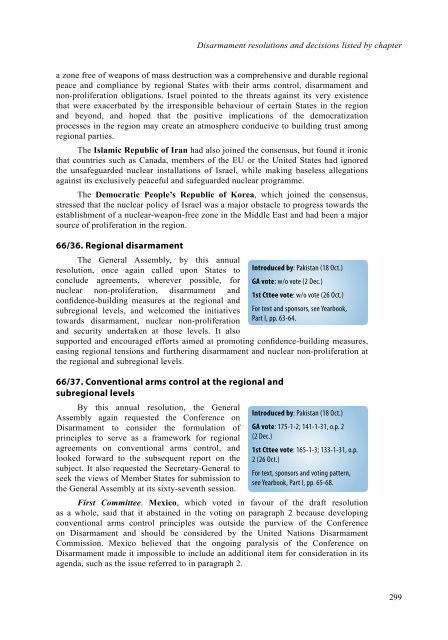DYB2011-Part-II-web
DYB2011-Part-II-web
DYB2011-Part-II-web
You also want an ePaper? Increase the reach of your titles
YUMPU automatically turns print PDFs into web optimized ePapers that Google loves.
Disarmament resolutions and decisions listed by chapter<br />
a zone free of weapons of mass destruction was a comprehensive and durable regional<br />
peace and compliance by regional States with their arms control, disarmament and<br />
non-proliferation obligations. Israel pointed to the threats against its very existence<br />
that were exacerbated by the irresponsible behaviour of certain States in the region<br />
and beyond, and hoped that the positive implications of the democratization<br />
processes in the region may create an atmosphere conducive to building trust among<br />
regional parties.<br />
The Islamic Republic of Iran had also joined the consensus, but found it ironic<br />
that countries such as Canada, members of the EU or the United States had ignored<br />
the unsafeguarded nuclear installations of Israel, while making baseless allegations<br />
against its exclusively peaceful and safeguarded nuclear programme.<br />
The Democratic People’s Republic of Korea, which joined the consensus,<br />
stressed that the nuclear policy of Israel was a major obstacle to progress towards the<br />
establishment of a nuclear-weapon-free zone in the Middle East and had been a major<br />
source of proliferation in the region.<br />
66/36. Regional disarmament<br />
The General Assembly, by this annual<br />
resolution, once again called upon States to<br />
conclude agreements, wherever possible, for<br />
nuclear non-proliferation, disarmament and<br />
confidence-building measures at the regional and<br />
subregional levels, and welcomed the initiatives<br />
towards disarmament, nuclear non-proliferation<br />
and security undertaken at those levels. It also<br />
supported and encouraged efforts aimed at promoting confidence-building measures,<br />
easing regional tensions and furthering disarmament and nuclear non-proliferation at<br />
the regional and subregional levels.<br />
66/37. Conventional arms control at the regional and<br />
subregional levels<br />
By this annual resolution, the General<br />
Assembly again requested the Conference on<br />
Disarmament to consider the formulation of<br />
principles to serve as a framework for regional<br />
agreements on conventional arms control, and<br />
looked forward to the subsequent report on the<br />
subject. It also requested the Secretary-General to<br />
seek the views of Member States for submission to<br />
the General Assembly at its sixty-seventh session.<br />
Introduced by: Pakistan (18 Oct.)<br />
GA vote: w/o vote (2 Dec.)<br />
1st Cttee vote: w/o vote (26 Oct.)<br />
For text and sponsors, see Yearbook,<br />
<strong>Part</strong> I, pp. 63-64.<br />
Introduced by: Pakistan (18 Oct.)<br />
GA vote: 175-1-2; 141-1-31, o.p. 2<br />
(2 Dec.)<br />
1st Cttee vote: 165-1-3; 133-1-31, o.p.<br />
2 (26 Oct.)<br />
For text, sponsors and voting pattern,<br />
see Yearbook, <strong>Part</strong> I, pp. 65-68.<br />
First Committee. Mexico, which voted in favour of the draft resolution<br />
as a whole, said that it abstained in the voting on paragraph 2 because developing<br />
conventional arms control principles was outside the purview of the Conference<br />
on Disarmament and should be considered by the United Nations Disarmament<br />
Commission. Mexico believed that the ongoing paralysis of the Conference on<br />
Disarmament made it impossible to include an additional item for consideration in its<br />
agenda, such as the issue referred to in paragraph 2.<br />
299


